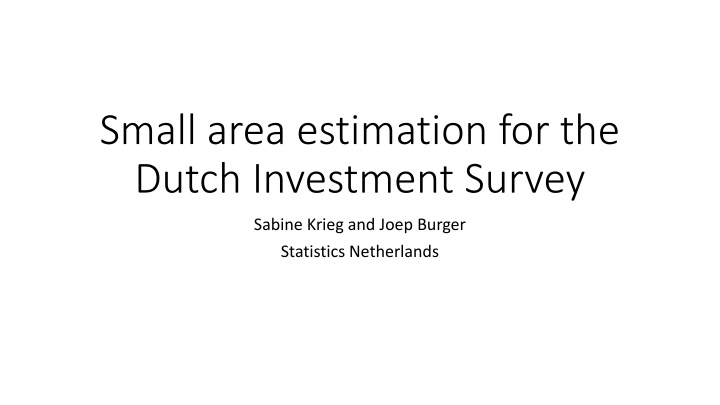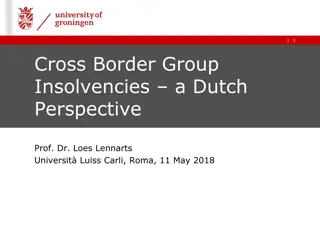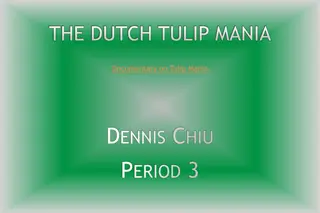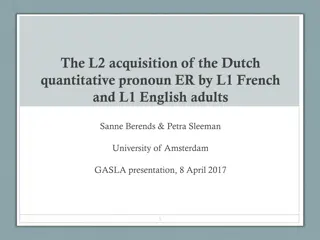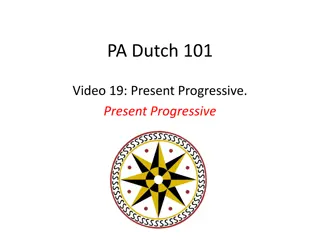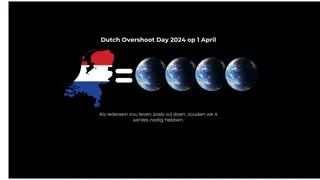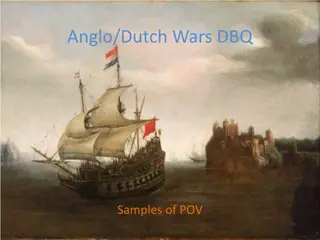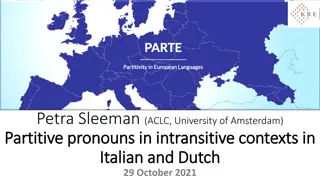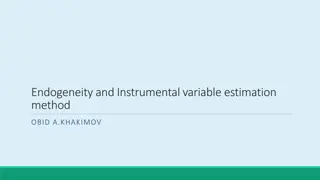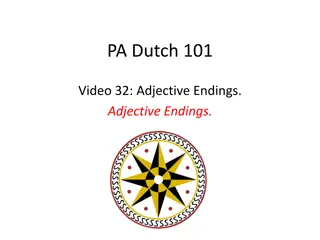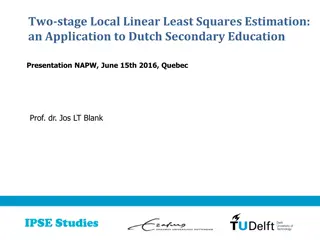Small Area Estimation Methods for the Dutch Investment Survey
Small area estimation techniques are investigated for the Dutch Investment Survey, aiming to estimate investments in municipalities using a sample of 20,000 enterprises. The study compares direct estimators with small area estimators, evaluating different specifications and methodologies. Two main methods are discussed: one involving transformations and a mixed model, and another using two models with indicator variables. Bayesian approaches are considered for both methods. Cross-validation is recommended for model selection.
Download Presentation

Please find below an Image/Link to download the presentation.
The content on the website is provided AS IS for your information and personal use only. It may not be sold, licensed, or shared on other websites without obtaining consent from the author.If you encounter any issues during the download, it is possible that the publisher has removed the file from their server.
You are allowed to download the files provided on this website for personal or commercial use, subject to the condition that they are used lawfully. All files are the property of their respective owners.
The content on the website is provided AS IS for your information and personal use only. It may not be sold, licensed, or shared on other websites without obtaining consent from the author.
E N D
Presentation Transcript
Small area estimation for the Dutch Investment Survey Sabine Krieg and Joep Burger Statistics Netherlands
Investment Survey Annual survey Large enterprises completely enumerated Small enterprises Stratified sample (inclusion probability depends on size and economic activity) Sample size 20,000 Target variable (here investments in tangible fixed assets) Often zero (no investments) Non-zeros skewed-distributed
Research question(s) How to estimate investments for municipalities (around 400 in NL)? Small area estimator (SAE) more accurate than direct estimator (HT or GREG)? Which specification of SAE works well? How to select this specification?
Artificial population In practice: only sample is known Here: artificial population, based on samples of 5 years Step 1: select specification, based on the sample only Step 2: compare with population values
Small area estimation, method 1 Transformation ???= ?(???); ? sample element, ? area (municipality) Mixed model ???= ????+ ??+ ???; ???auxiliary information, ??random effect Model borrows strength from other areas through ? Sum of model predictions = estimate for each area Without transformation: EBLUP (Battese, Harter and Fuller, 1988) With transformation: Chandra and Chambers (2011) Here: Bayesian approach
Small area estimation, method 2 (two models) ???= ?????? ???indicator variable (0/1) ??? Mixed model 1 for ??? Mixed model 2 for ??? Sum of model predictions (combination of 2 models) = estimate for each area Pfeffermann, Terryn and Moura (2008) Chandra and Sud (2012) Here: Bayesian approach positive, continuous = ?(??? )
Cross validation as model selection method Idea: estimate model (or both models) with (large) part of the sample Predict for the remainder of the sample Repeat until there are predictions for all sample elements Compare predictions with true sample values Here: mean squared prediction error for all models larger than prediction 0. Therefore: consider predictions at area level
Other model selection methods Plausibility: compare model estimates with direct estimates Large differences are suspicious Standard errors of the model estimates Biased in case of model misspecification Check of model assumptions
Investigated models (1) Model One Two 3 3 Incl weights Heterosc\Transf no log no log No No No Yes Yes No Yes Yes
Investigated models (2) Auxiliary information Different kinds of random effects Different versions of modelling heteroscedasticity Different models for indicator variable Result: no strong influence (weak auxiliary information)
Results Model One Two 3 3 Incl weights Heterosc\Transf no log no log 0 ++ 0 ++ ++ ++ + 0 ++ 0 ++ + ++ No No + 0 ++ + + + 0 0 ++ + ++ No Yes 0 0 ++ ++ ++ + 0 0 ++ ++ ++ ++ Yes No + 0 ++ + + + 0 0 ++ + ++ Yes Yes ++ very accurate not accurate green SE, red CV, blue compare with true value
Results Model One Two 3 3 Incl weights Heterosc\Transf no log no log 0 ++ 0 ++ ++ ++ + 0 ++ 0 ++ + ++ No No + 0 ++ + + + 0 0 ++ + ++ No Yes 0 0 ++ ++ ++ + 0 0 ++ ++ ++ ++ Yes No + 0 ++ + + + 0 0 ++ + ++ Yes Yes ++ very accurate not accurate green SE, red CV, blue compare with true value
Results Model One Two 3 3 Incl weights Heterosc\Transf no log no log 0 ++ 0 ++ ++ ++ + 0 ++ 0 ++ + ++ No No + 0 ++ + + + 0 0 ++ + ++ No Yes 0 0 ++ ++ ++ + 0 0 ++ ++ ++ ++ Yes No + 0 ++ + + + 0 0 ++ + ++ Yes Yes ++ very accurate not accurate green SE, red CV, blue compare with true value
Results Model One Two 3 3 Incl weights Heterosc\Transf no log no log 0 ++ 0 ++ ++ ++ + 0 ++ 0 ++ + ++ No No + 0 ++ + + + 0 0 ++ + ++ No Yes 0 0 ++ ++ ++ + 0 0 ++ ++ ++ ++ Yes No + 0 ++ + + + 0 0 ++ + ++ Yes Yes ++ very accurate not accurate green SE, red CV, blue compare with true value
Results Model One Two 3 3 Incl weights Heterosc\Transf no log no log 0 + 0 0 ++ ++ No No 0 + 0 ++ No Yes + ++ ++ ++ Yes No 0 + 0 ++ Yes Yes ++ very accurate not accurate blue compare with true value
Conclusions SAE can improve accuracy of estimates for municipalities Different specifications work well Take properties of data into account Two models Third root transformation Inclusion weights Some other specifications also accurate Model selection methods correctly find non-accurate specifications But do not distinguish between moderate and good specifications
